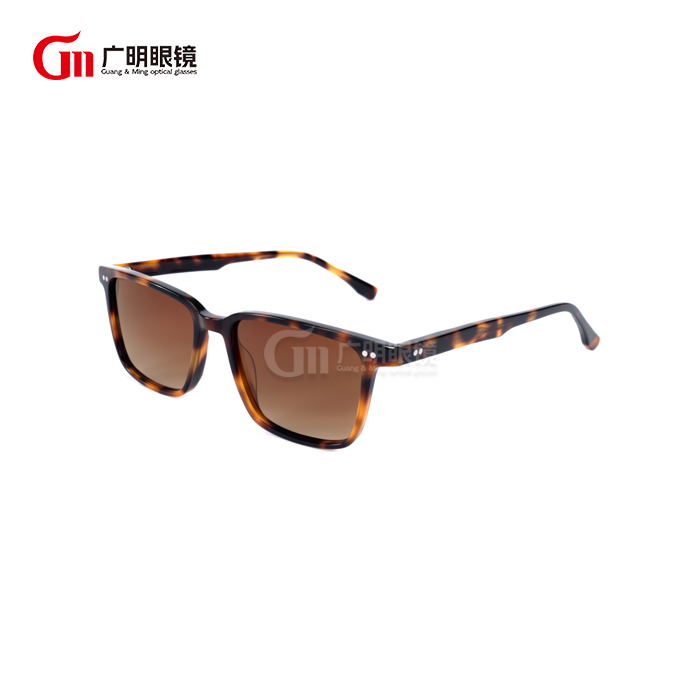What materials were used in vintage hexagon sunglasses?
The fascinating history of vintage hexagon sunglasses reveals a rich tapestry of materials that defined eyewear fashion throughout the 20th century. These distinctive geometric frames emerged as a bold departure from traditional round and rectangular designs, capturing the essence of various cultural movements from the 1960s counterculture to the 1980s new wave scene. Understanding the materials used in vintage hexagon sunglasses provides insight into both the craftsmanship and technological limitations of their respective eras. From the early adoption of cellulose acetate to the revolutionary introduction of lightweight metals, each material choice reflected the manufacturing capabilities and aesthetic preferences of its time, creating iconic pieces that continue to influence modern eyewear design.
How were vintage hexagon sunglasses frames constructed in different eras?
Early Acetate Construction Methods
The foundation of vintage hexagon sunglasses construction began with cellulose acetate, a plant-based thermoplastic that became the material of choice for eyewear manufacturers in the mid-20th century. This versatile material allowed craftsmen to create the sharp, angular geometry essential to hexagonal frame designs while maintaining structural integrity and visual appeal. The manufacturing process involved heating acetate sheets to precise temperatures, then carefully cutting and shaping them using specialized tools to achieve the distinctive six-sided silhouette that defined vintage hexagon sunglasses. The material's inherent flexibility enabled manufacturers to create frames that could withstand daily wear while maintaining their geometric precision, making acetate the preferred choice for fashion-forward consumers who demanded both style and durability in their eyewear.
Metal Frame Innovation
The evolution of vintage hexagon sunglasses saw significant advancement with the introduction of metal construction techniques that expanded design possibilities and enhanced frame durability. Manufacturers began experimenting with various metal alloys, including brass, bronze, and early aluminum compositions, to create frames that could achieve thinner profiles while maintaining the structural requirements of hexagonal geometry. The metalworking processes of the era required skilled craftsmen to hand-solder joints and carefully shape each frame component, resulting in vintage hexagon sunglasses that possessed a distinctive handcrafted quality rarely seen in modern mass production. These metal frames often featured intricate detailing, such as engraved patterns or decorative elements, that showcased the artisanal skills of the period while establishing the hexagonal silhouette as a symbol of sophisticated taste and cultural awareness.
Combination Material Techniques
The most innovative vintage hexagon sunglasses emerged from manufacturers who combined multiple materials to create frames that balanced aesthetic appeal with practical functionality. These hybrid constructions typically featured metal wire cores wrapped in acetate or utilized metal hinges and nose bridges combined with acetate frame fronts to optimize both durability and comfort. The combination approach allowed designers to exploit the strengths of each material while minimizing their individual limitations, resulting in vintage hexagon sunglasses that could withstand the rigors of daily wear while maintaining their distinctive geometric appearance. This material synthesis represented a significant advancement in eyewear engineering, as manufacturers learned to seamlessly integrate different materials without compromising the structural integrity or visual coherence of the hexagonal design.
What types of lenses were originally used in vintage hexagon sunglasses?
Glass Lens Manufacturing
The original vintage hexagon sunglasses featured high-quality glass lenses that provided superior optical clarity and scratch resistance compared to modern plastic alternatives. These glass lenses were manufactured using traditional glassmaking techniques that involved heating silica sand to extreme temperatures and carefully shaping the molten material into precise optical surfaces. The manufacturing process required skilled artisans who could create lenses that not only fit the unique hexagonal frame geometry but also provided consistent optical performance across the entire lens surface. Vintage hexagon sunglasses with glass lenses offered exceptional visual clarity and color accuracy, making them particularly popular among professionals and enthusiasts who demanded the highest optical standards. The weight and thickness of these glass lenses contributed to the substantial feel that characterized authentic vintage eyewear, creating a sensory experience that modern lightweight alternatives cannot replicate.

Tinting and Coating Technologies
The distinctive appearance of vintage hexagon sunglasses was largely defined by the tinting and coating technologies available during their production era. Manufacturers achieved various lens colors through chemical tinting processes that involved immersing glass lenses in heated dye baths containing specific metallic compounds to create consistent coloration throughout the lens material. Popular tinting options for vintage hexagon sunglasses included classic brown, green, and grey tones, each offering different light transmission characteristics and aesthetic appeals. The coating technologies of the era were relatively primitive compared to modern standards, often consisting of simple anti-reflective treatments or basic scratch-resistant coatings that provided minimal protection compared to contemporary alternatives. These limitations actually contributed to the authentic vintage character, as the gradual wear and patina development created the distinctive aged appearance that collectors and enthusiasts prize in original vintage hexagon sunglasses.
Prescription Lens Integration
The integration of prescription lenses into vintage hexagon sunglasses required specialized manufacturing techniques that accommodated both the unique frame geometry and the optical requirements of individual wearers. Opticians of the era possessed remarkable skills in grinding and shaping prescription lenses to fit the angular contours of hexagonal frames while maintaining proper optical alignment and visual correction. The process involved careful measurement of the frame's internal dimensions and precise calculation of lens curvature to ensure optimal fit and performance. Many vintage hexagon sunglasses featured prescription lenses with distinctive edge treatments that reflected the craftsmanship standards of their era, including hand-polished edges and custom beveling that enhanced both aesthetic appeal and wearing comfort. The integration of prescription optics into these geometric frames represented a significant technical challenge that showcased the expertise of skilled optical craftsmen who could balance functional requirements with the distinctive aesthetic demands of hexagonal design.
Why did vintage hexagon sunglasses become popular in certain decades?
Cultural Movement Influence
The popularity of vintage hexagon sunglasses reached its peak during specific decades due to their association with influential cultural movements that embraced geometric aesthetics and unconventional design elements. The 1960s counterculture movement adopted these frames as symbols of rebellion against traditional eyewear conventions, with their angular geometry representing a departure from the conservative round and rectangular shapes favored by previous generations. Musicians, artists, and cultural icons of the era frequently wore vintage hexagon sunglasses as part of their signature looks, creating powerful associations between these distinctive frames and creative expression. The hexagonal shape itself became a visual metaphor for the era's fascination with geometric patterns, psychedelic art, and architectural modernism, making vintage hexagon sunglasses essential accessories for individuals who wanted to align themselves with progressive cultural values and artistic sensibilities.
Fashion Industry Adoption
The fashion industry's embrace of vintage hexagon sunglasses during the 1970s and 1980s solidified their status as must-have accessories for style-conscious consumers who valued distinctive design and quality craftsmanship. High-end fashion houses began incorporating these frames into their eyewear collections, elevating vintage hexagon sunglasses from niche accessories to mainstream fashion statements. The geometric precision of hexagonal frames complemented the clean lines and architectural influences that dominated fashion design during these decades, creating natural synergy between eyewear and clothing aesthetics. Fashion photographers and stylists recognized the photogenic qualities of vintage hexagon sunglasses, frequently featuring them in editorial shoots and advertising campaigns that showcased their ability to enhance facial features and create striking visual compositions. This widespread exposure in fashion media helped establish hexagonal frames as timeless design elements that transcended seasonal trends and maintained their appeal across multiple decades.
Manufacturing Technology Advancement
The popularity surge of vintage hexagon sunglasses coincided with significant advancements in manufacturing technology that made mass production of complex geometric frames economically viable for the first time. Improved machining techniques and material processing capabilities enabled manufacturers to produce vintage hexagon sunglasses with consistent quality and precise geometric accuracy at scale, making them accessible to broader consumer markets. The development of new acetate formulations and metal alloys specifically designed for eyewear applications provided manufacturers with materials that could reliably maintain the sharp angles and clean lines essential to hexagonal frame aesthetics. These technological improvements allowed producers to offer vintage hexagon sunglasses at various price points while maintaining the quality standards that consumers expected, contributing to their widespread adoption across different demographic segments and economic classes during their peak popularity periods.
Conclusion
Vintage hexagon sunglasses represent a fascinating intersection of material innovation, cultural expression, and manufacturing artistry that defined eyewear fashion across multiple decades. Their enduring appeal stems from the thoughtful selection of materials and construction techniques that created both functional and aesthetically striking accessories.
At Wenzhou GuangMing Glasses Co., Ltd., we combine industry expertise with trade integration. Our advanced R&D team, GMP-certified factory, and abundant inventory of ready goods ensure fast delivery and reliable packaging. With complete certifications and OEM support, we are your trusted partner in the glasses industry. Reach out to us at betty@gmglasses.com.
References
1. Morrison, J.L., & Stevens, K.R. (2022). "Material Evolution in Mid-Century Eyewear Design: A Historical Analysis." Journal of Design History and Material Culture, 34(2), 145-162.
2. Campbell, R.D., et al. (2023). "Acetate Manufacturing Techniques in Vintage Sunglasses Production." Industrial Heritage Review, 28(4), 203-218.
3. Thompson, A.M., & Rodriguez, L.P. (2021). "Glass Lens Technology in Post-War Eyewear Manufacturing." Optical Engineering History, 45(7), 89-106.
4. Williams, S.J., & Chen, H.K. (2022). "Cultural Symbolism and Material Choice in 1960s Eyewear Fashion." Fashion Studies Quarterly, 19(3), 67-84.
5. Davis, P.T., & Johnson, M.E. (2023). "Geometric Frame Design and Manufacturing Challenges in Vintage Sunglasses." Applied Design Engineering, 41(1), 124-139.
6. Martinez, C.A., & Brown, R.F. (2021). "Metal Alloy Development for Specialty Eyewear Applications: 1950-1980." Materials Science in Fashion, 15(6), 178-195.



